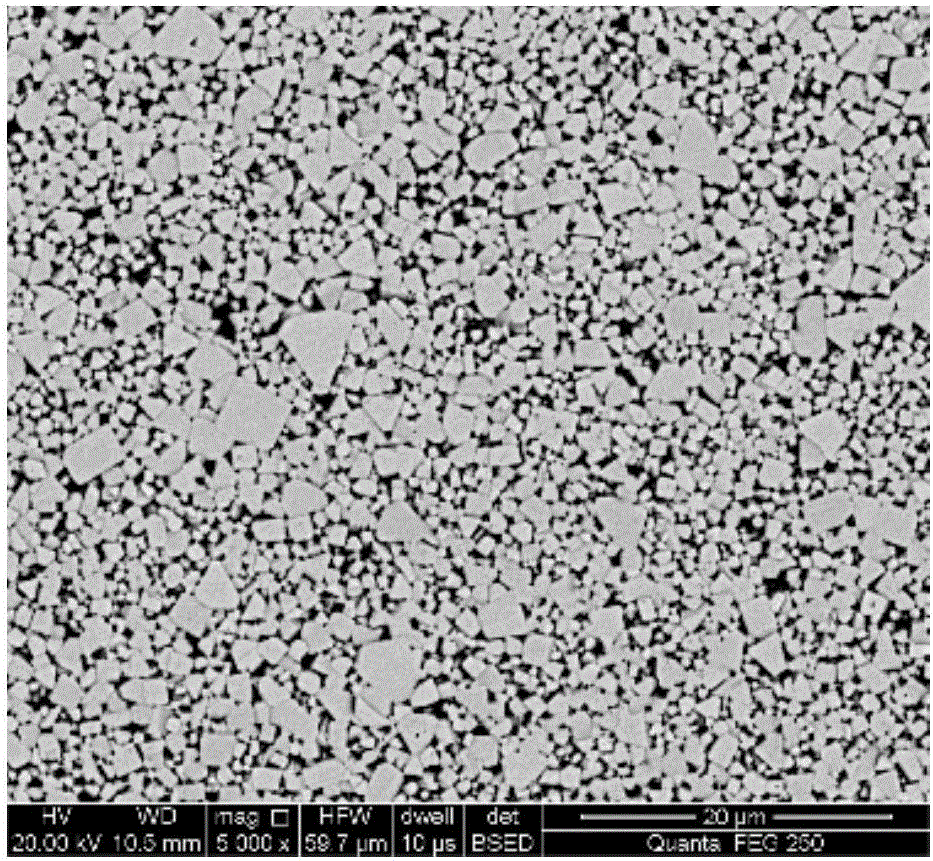A method of directly adding refractory metal to prepare gradient cemented carbide
A refractory metal and cemented carbide technology, applied in the field of cemented carbide material manufacturing, can solve the problems of reducing the hardness and strength of alloys, lack of special research, grain growth, etc., and achieve slow decline in surface hardness, long service life, Excellent high temperature oxidation resistance
- Summary
- Abstract
- Description
- Claims
- Application Information
AI Technical Summary
Problems solved by technology
Method used
Image
Examples
Embodiment 1
[0040] step one
[0041] The carbon-poor cemented carbide powder containing the refractory metal is press-formed, and then pressurized and sintered to obtain a carbon-poor pre-sintered matrix; the carbon-poor cemented carbide powder containing the refractory metal includes by mass percentage:
[0042] WC powder 87.5%; Co powder 6%; W powder 6%; refractory metal powder Nb 0.5%; the total content of carbon in the carbon-poor cemented carbide powder containing refractory metal is 5.32wt.%.
[0043] The particle size of the WC powder is 2 μm; the particle size of the Co powder is 2.0 μm; the particle size of the W powder is 1.5 μm; the particle size of the refractory metal powder is 1.5 μm;
[0044] Its specific operation has been called:
[0045] According to the mass ratio, binder: carbon-poor cemented carbide powder containing refractory metal = 1:50, put the binder paraffin and the prepared WC powder, Co powder, W powder, and Nb powder into the ball mill In the process, afte...
Embodiment 2
[0062] Other conditions are exactly the same as in Example 1, except that the refractory metal is replaced by V, the forming pressure is 200MPa, and the carburizing temperature is 1440°C; the specific testing items and testing results are shown in Table 3;
[0063] table 3
[0064]
[0065]
[0066] It can be seen from Table 3 and Table 2 that
[0067] The gradient alloy prepared in Example 2 of the present invention, after carburizing for 40 to 240 minutes, has a hardness of more than 90HRA, which is slightly improved compared with the alloy without refractory elements; the transverse fracture strength is increased by about 10 on average; the high temperature hardness is higher than that of ordinary Carbide improves by about 10%. After 240min of carburizing, the grain growth of the alloy is not obvious. And in the whole alloy, the Co content is low in the outer layer, high in the middle layer, and normal in the inner layer.
Embodiment 3
[0069] Other conditions are exactly the same as in Example 1, except that the refractory metal is replaced by Cr, the forming pressure is 300MPa, and the carburizing temperature is 1460°C; the specific testing items and testing results are shown in Table 4;
[0070] Table 4
[0071]
[0072]
[0073] It can be seen from Table 4 and Table 2 that
[0074] The gradient alloy prepared in Example 2 of the present invention, after carburizing for 40 to 240 minutes, has a hardness of above 91HRA, which is slightly improved compared with ordinary cemented carbide, and the transverse fracture strength is obviously improved; compared with that without adding refractory metal elements Alloy improved about 20%, 30% higher than ordinary cemented carbide. The high-temperature hardness is about 10% higher than that of ordinary cemented carbide. And in the whole alloy, the Co content is low in the outer layer, high in the middle layer, and normal in the inner layer.
[0075] It can b...
PUM
| Property | Measurement | Unit |
|---|---|---|
| thickness | aaaaa | aaaaa |
| particle size | aaaaa | aaaaa |
| particle size | aaaaa | aaaaa |
Abstract
Description
Claims
Application Information
 Login to View More
Login to View More - R&D
- Intellectual Property
- Life Sciences
- Materials
- Tech Scout
- Unparalleled Data Quality
- Higher Quality Content
- 60% Fewer Hallucinations
Browse by: Latest US Patents, China's latest patents, Technical Efficacy Thesaurus, Application Domain, Technology Topic, Popular Technical Reports.
© 2025 PatSnap. All rights reserved.Legal|Privacy policy|Modern Slavery Act Transparency Statement|Sitemap|About US| Contact US: help@patsnap.com



